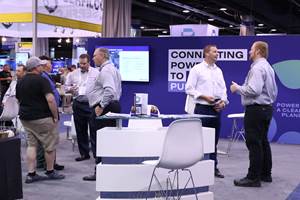PFAS and the Surface Finishing Industry
NASF and its member companies have a long history of environmental stewardship, especially when it comes to PFAS.
The National Association for Surface Finishing (NASF) recently launched a section on their website that addresses the issue of perfluorooctane sulfonate (PFOS). Below is a some information from that section. Please visit nasf.org/pfas/ to get more information on the topic of PFOS and actions by the NASF.
The National Association for Surface Finishing (NASF) represents the interests of businesses, technologists and professionals in the surface coatings industry. NASF and its member companies have a long history of environmental stewardship. It is the only industry in the U.S. to have requested a ban from the U.S. Environmental Protection Agency (EPA) on the use of perfluorooctane sulfonate (PFOS) nearly 10 years ago.
Due to the association’s efforts, the EPA banned the use of PFOS from use in the industry in 2012. NASF and its members have continued to work proactively with the EPA, the Michigan Department of Environmental Quality (MDEQ) and other stakeholders in Michigan, at the national level and globally, to find effective solutions to reduce and eliminate PFOS in wastewater discharges.
History of Proactive Environmental Stewardship for PFOS
Beginning in 1995, the EPA recommended the use of PFOS as a fume suppressant in the chromium electroplating process. The amount of PFOS used represented a tiny fraction of all commercial uses. It’s estimated that the use of PFOS in the surface finishing industry represented less than one half of one percent of U.S. and global PFOS use.
It’s also estimated that 30-40% of surface finishing facilities have chromium electroplating processes. Over 10 years ago, the surface finishing industry began working with the EPA and Minnesota to eliminate the use of PFOS as a fume suppressant (based on early findings of PFOS in wastewater from chromium plating operations).
NASF proactively approached the EPA and began a process that led to the industry requesting a national, industrywide EPA ban on the use of PFOS in chromium plating operations. That ban was finalized under a new federal Clean Air Act rule in 2012 and went into full effect in 2015.
The industry took steps during that time to adopt safer, EPA‐approved, commercially available alternatives for fume suppression. The industry has since been working to explore and utilize both EPA-approved fluorinated and nonfluorinated based alternatives as fume suppressants.
PFOS in Wastewater Discharge
Industry and regulatory agencies are uncertain why PFOS has been found to be present at trace levels in wastewater from some surface finishing facilities. As the issue has come to light, NASF has engaged with the EPA, MDEQ, wastewater treatment plant community, industry partners and other stakeholders in the U.S., Europe and Asia in an effort to gain a more thorough understanding of why trace amounts of PFOS may still be present, where it’s coming from and the most effective solutions for minimizing and eliminating residual concentrations.
More sensitive testing has revealed trace amounts of PFOS in wastewater effluent discharges from some Michigan surface finishing facilities, even though the surface finishing industry no longer uses PFOS. As analytical testing technology has become far more sensitive, PFOS detection values have been lowered from parts-per-billion to parts-per-trillion (ppt). Tests today can measure close to 1 ppt, the equivalent of a single drop in about 20 Olympic-size swimming pools.
NASF Taking Steps to Address Issue
NASF has been working to develop and launch a national research project to understand why PFOS may be present in the wastewater effluent of plants that haven’t used PFOS in years or, in some cases, ever.
As we have in the past, we are working to bring together federal and state agencies and other stakeholders across the region (including the EPA, EPA Region 5, Michigan DEQ and wastewater treatment plants) to research this unexpected finding and to effectively address the issue.
Please visit nasf.org/pfas. Contact Christian Richter at crichter@thepolicygroup.com or Jeff Hannapel at jhannapel@thepolicygroup.com.
Related Content
Electroplating in the Context of Worldwide Nanotechnology Initiatives: A Heritage Paper
In the first part, a summary is presented on recently established nanotechnology initiatives in various countries around the world. Program funding levels and core activities will be compared to provide a basis for assessing business opportunities for various industries. The second part of the paper looks at specific examples of nanostructures made by electrochemical methods currently at various stages in their development, or already in use.
Read MoreHighlights from SUR/FIN 2023
Products Finishing offers a recap of some of the topics that were top of mind at the SUR/FIN 2023 finishing industry trade show.
Read MoreOSHA, DOT and EPA Penalties Increase for 2023
The Department of Labor to revise civil penalty amounts for employer OSHA violations.
Read MoreNASF's SUR/FIN 2023: Bringing the Surface Finishing Industry Together
SUR/FIN 2023 is an opportunity for those in the surface finishing industry to expand their knowledge, expertise and network.
Read MoreRead Next
A ‘Clean’ Agenda Offers Unique Presentations in Chicago
The 2024 Parts Cleaning Conference, co-located with the International Manufacturing Technology Show, includes presentations by several speakers who are new to the conference and topics that have not been covered in past editions of this event.
Read MoreDelivering Increased Benefits to Greenhouse Films
Baystar's Borstar technology is helping customers deliver better, more reliable production methods to greenhouse agriculture.
Read MoreEducation Bringing Cleaning to Machining
Debuting new speakers and cleaning technology content during this half-day workshop co-located with IMTS 2024.
Read More




















